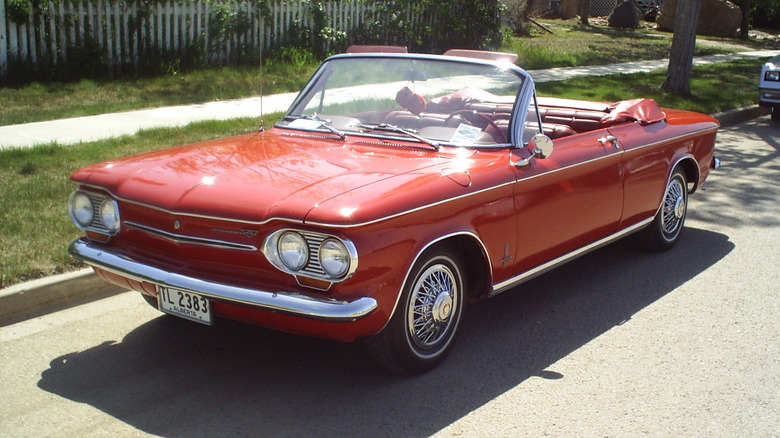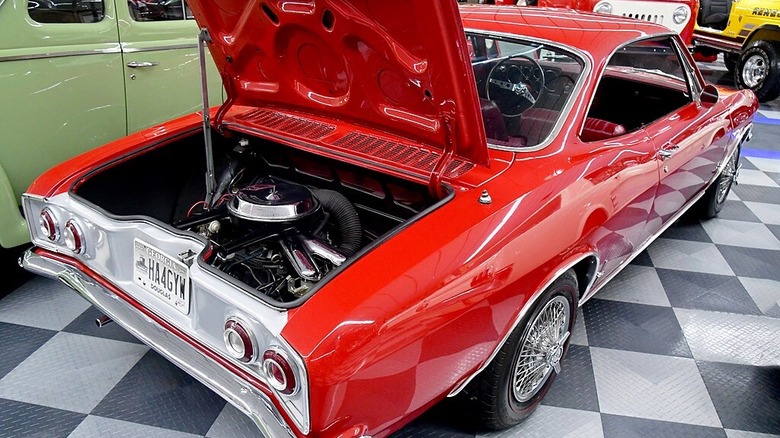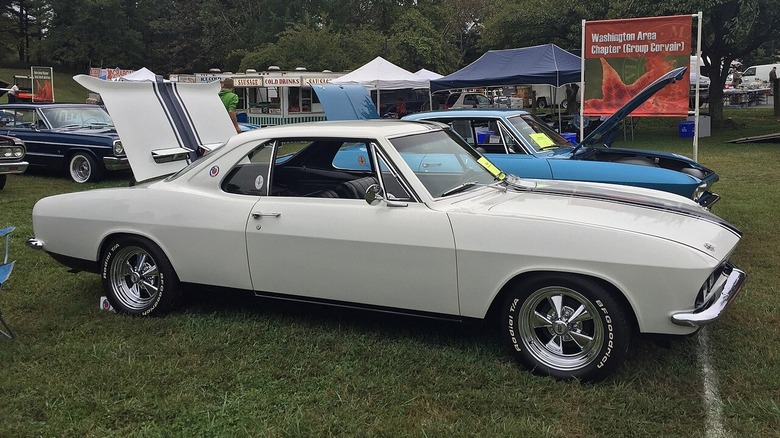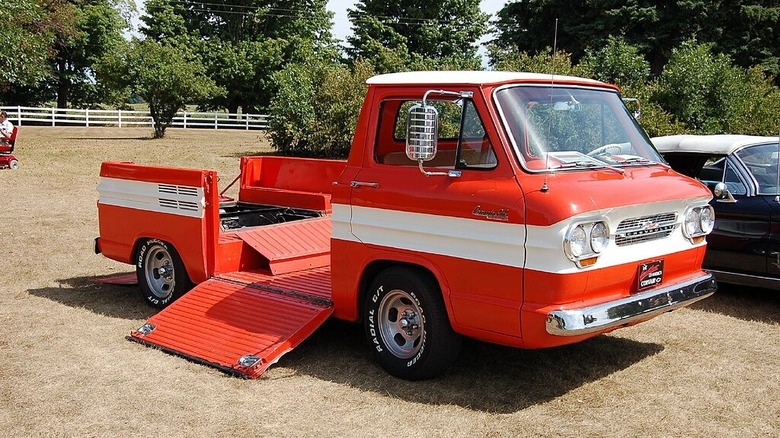Is The Chevy Corvair Considered A 'Classic,' And How Much Is One Worth Today?
The Chevrolet Corvair was a rear-engine car manufactured between 1960 and 1969, becoming GM's first vehicle powered by an all-aluminum, air-cooled, flat-six engine. It also happened to be the first Detroit-built car with a unibody design. Since the engine was in the back, all of the car's weight sat behind the rear swing axle, giving it the propensity to spin out and potentially roll over.
Making matters worse, in 1965, political activist and consumer advocate Ralph Nader released a book called "Unsafe at Any Speed" wherein he took GM to task for Corvair's safety issues and extrapolated that to claim the entire automobile industry had a complete and total disregard for public safety as a whole when it came to designing vehicles. This book was instrumental in passing the National Traffic and Motor Vehicle Safety Act in 1966, which allowed the government to create a legion of safety standards that the entire automobile industry had to follow if they wanted to sell cars in the United States.
Even as recently as 2017, the Corvair made it onto Time Magazine's list of "50 Worst Cars of All Time," citing the spinning-out problem along with other issues, like a single-piece steering column capable of skewering the driver, constant oil leaks, and a heating system that blew harmful engine fumes into the main cabin. Despite all those problems, "Car and Driver" called it a "poor man's Porsche" during a 1963 road test, and it's now considered a "classic car" in most collector circles.
[Featured image by dave_7 via Wikimedia Commons | Cropped and scaled | CC BY-SA 2.0]
A Detroit-made rear engine classic
What's a "classic" car? The Classic Car Club of America (CCCA) has very stringent requirements – the vehicle had to be built between 1915 and 1948 and can't be "mass-produced" on an assembly line. Meanwhile, both Hagerty and American Collector Insurance require a car to be at least 20 years old, but that doesn't necessarily make it a "classic" per se. Thus, the definition is wholly subjective and depends on what your state laws, insurance company, or car club have to say.
The Corvair had several things going for it that make it a "classic" — besides its age. It boasted Chevrolet's interesting flat-six engine (aka Turbo-Air 6) and was GM's first unibody production car. The first-generation Corvairs (1960 to 1964) used a swing axle rear suspension (like a Volkswagen Bug), but the second-generation models (1965 to 1969) fixed the roll problem by installing a fully independent rear suspension. Additional models introduced exhaust gas-driven turbocharging.
What's more, it came in various body styles, including a sedan, convertible, coupe, wagon, and even a van. The MSRP for a 1960 Chevrolet Corvair 500 4-door sedan was $2,038. The sportier Monza (1961) had bucket seats and a floor shifter with an MSRP starting around $2,200, making it a fun, affordable, economical car. A convertible arrived in '62 (MSRP of $2,483), along with a new turbocharged Spyder, an option package available only on Monzas for an extra $421.95. By comparison, a '62 Porsche 356B retailed for $4,289, making it as close as the average American working Joe got to a Porsche.
[Featured image by Eric Friedebach via Wikimedia Commons | Cropped and scaled | CC BY-SA 2.0]
What are they worth today?
Another notable feature appeared in the second-generation Corvair released in 1965 – a sculpted "character line" wrapped around the entire car. This crease ran through the fenders, doors, and fascias, adding personality to the vehicle. It was a styling detail that virtually every automobile manufacturer quickly adopted.
While the charming first-gen Corvairs have more historical significance thanks to all of their firsts, the second generation of vehicles is considered more collectible. The value hinges primarily on the usual suspects of condition and mileage but really depends on which Corvair model you're seeking.
The latest data from Classic.com shows that although total sales for both generations are relatively close (205 first gens compared to 226 second gens sold over the last five years), the dollar amounts do differ. First gens sell for an average of $13,669 (with a high sale topping out at $47,300), while second gens average $18,205 (and had a high sale of $82,500) — but with a caveat. Three of the four second-generation cars that sold north of $60,000 were special COPO Yenko Stingers, a special Corvair modified by Chevrolet's central office with additional tweaks completed by Yenko Chevrolet built to compete in SCCA (Sports Car Club of America) racing.
Convertibles led the pack in sales over the last five years for both generations. The Monza Spyder (which was driven by Andrea Braugher in "Brooklyn Nine-Nine") is the typical high-dollar earner for first-gen Corvairs, and the Corsa and Monza models often sell well north of the $18k average for second-gen models.
[Featured image by Christopher Ziemnowicz via Wikimedia Commons | Cropped and scaled | CC BY-SA 4.0]
Beauty and value are in the eye of the beholder
Then you have the much rarer pickup and van models, both part of the "Corvair 95" family. The truck was available from 1961 until 1964 and came in two versions, a "Rampside" that — as the name implies — had a side opening ramp, and a "Loadside" that came with a standard rear tailgate, but which was interestingly the rarer of the two. Meanwhile, the Greenbrier van was sold between '61 and '65 and came in six or eight-door versions.
Most of the trucks sold over the last five years were the "Rampside" model, with an average sale price of $28,046, substantially higher than the average sale prices of coupes, convertibles, and sedans. In fact, the top sale price for a '63 Rampside (keep in mind only 55 have sold since 2019, according to Classic.com) went for $88,000 in May 2020, eclipsing even a Yenko Stinger. A mere 18 vans have sold in five years, earning an average sale price of $22,684, but with one topping out at $103,400.
One last thing to keep in mind: Back in October 1964, the prestigious automobile magazine "Car and Driver" went on record saying, " ... the Corvair is in our opinion — the most important new car of the entire crop of '65 models, and the most beautiful car to appear in this country since before World War II." The Corvair is one of the vehicles we think Chevy never should've discontinued, and there's no shortage of them available for sale across a wide range of price points to suit any level of interest.
[Featured image by Joe Ross via Wikimedia Commons | Cropped and scaled | CC BY-SA 2.0]



